Popularly known as the Golden Rock, Kyaikthiyo is a famous Buddhist pilgrimage site that devout followers of the religion must visit at least once in their lifetime.
Kyaikthiyo, in the Mon language, means “the pagoda upon a hermit’s head” — and that’s pretty much what it looks like.
Only third in terms of religious significance to the Shwedagon Pagoda in Yangon and the Mahamuni Buddha Temple in southwest Mandalay, the Golden Rock Pagoda is the perfect weekend get-away from Yangon even for those who aren’t going for religious reasons.
After the Tazaungdaing festival, marking the end of the monsoon season, thousands pilgrimage to Kyaikthiyo. Beginning in November, Buddhists from across Myanmar make the journey to Mon State to meditate, chant recitations and make offerings well into the night. The pilgrimage season ends in March during the Full Moon of Tabaung when 90,000 candles are lit as an offering to the Buddha.

The pagoda itself is small and sits on top of a gold-covered granite boulder that’s perched precariously on the edge of a small mountain. It looks like it’s always on the verge of toppling, on the verge of rolling into the valley below.
According to local legends, the Golden Rock is held in place by a single strand of the Buddha’s hair that was gifted to a hermit. Later, the hermit gifted the relic to his king and it was enshrined in a small pagoda on top of a boulder shaped like the hermit’s head.
It is widely believed that the rock is in fact hovering on the hill, instead of simply balanced on the edge. Over the years, the rock has sunk further and further until the gap became so small that the boulder and the cliff pretty much seem to be touching.
However, if you look closely, there is a visible gap.

There is a fair amount of confusion when it comes to the spot’s name, as there are three that commonly get used when Burmese refer to the site: Kyaikto, Kinpun and Kyaikthiyo.
So, where is the Golden Rock, how do I get there, are Kyaikto and Kyaikthiyo the same place, and how do I know which one is which?
Here’s a little cheat sheet for that:
- Kyaikto is the Mon town along the highway from Yangon to Mawlamyine. The town is 14km away from Kinpun and 28km away from Kyaiktiyo.
- Kinpun is the name of the town at the foot of the mountain, referred to as the “base camp”. There are direct buses to this base camp from all over Myanmar.
- Kyaikthiyo is the name of the town built around the Golden Rock to serve the thousands of pilgrims that come every day in the high season from November to March.
How to get there
Kyaikthiyo is 200km away from Yangon and there are three main ways of getting there: by bus, train or car.
There are direct buses from across Myanmar to Kinpun base camp. From Yangon, 7,000 kyats on Win-Express will get you directly to Kinpun after 4 1/2 hours. Buses depart from early morning until 2:30 in the afternoon.
There are three bumpy trains from Yangon that leave at 7:15 AM, 6:25 P.M. and 9PM, arriving at Kyaikto Train Station about 6 hours later. Once you arrive, there are regular pick-ups that run from Kyaikto to Kinpun all day for 500 kyats each way. Motor-taxi drivers that approach you at the train station will charge from 2,000 kyats onward for a ride to the base camp.
Kinpun base camp is where the journey to Kyaikthiyo begins in earnest. Throngs of pilgrims are clamoring for a ride up to Kyaikthiyo at the Kinpun Truck Station. General truck tickets are 2,000 kyats, and the VIP seats in the front (there are 5) are 3,000 kyats a piece. The VIP ones are a hard get; you have to book well in advance and be in a party of 5 to book and board these rides.

The trucks have been retrofitted with wooden planks (with seatbelts that don’t click) to seat about 40 to 45 people in the back. The roofs open up when the trucks park next to metal passenger boarding stairs for easy boarding and exiting.
Arranged by the Ministry of Religion, these trucks are meant for pilgrims and tourists alike. They only leave when the entire truck is full, so the wait time can range from 5 minutes in the peak season and up to an hour during monsoon times. The trucks start going up the hill at dawn, and the last bus comes back down the hill around sunset.
This is important: Plan accordingly, or you risk being stranded at the top of the mountain.
There are many hotels at the Kinpun base camp that you can spend the night in, but there are also more expensive options on the hill in Kyaikthiyo town. Just remember to come back on the last bus at sunset if you have a hostel booked in Kinpun.
There is also the option of hiking up the hill from Kinpun. It is a steep climb of four to five hours, but there are breathtaking views along the path that are hard to appreciate if you’re on a bumpy truck ride.


The truck drivers are adept at navigating the steep and sharp turns up the hill but the passengers in the back are treated to a rollercoaster ride in the Mon hills.

Halfway up at the base of Ya Thae mountain, the trucks stop so that you have the option of taking a cable car up to the Kyaikthiyo town, or continue onwards in the open air bus. For 6,000 kyats, you can purchase a round-trip ticket; 4,000 kyats will get you up one-way from the halfway point to Kyaikthiyo.
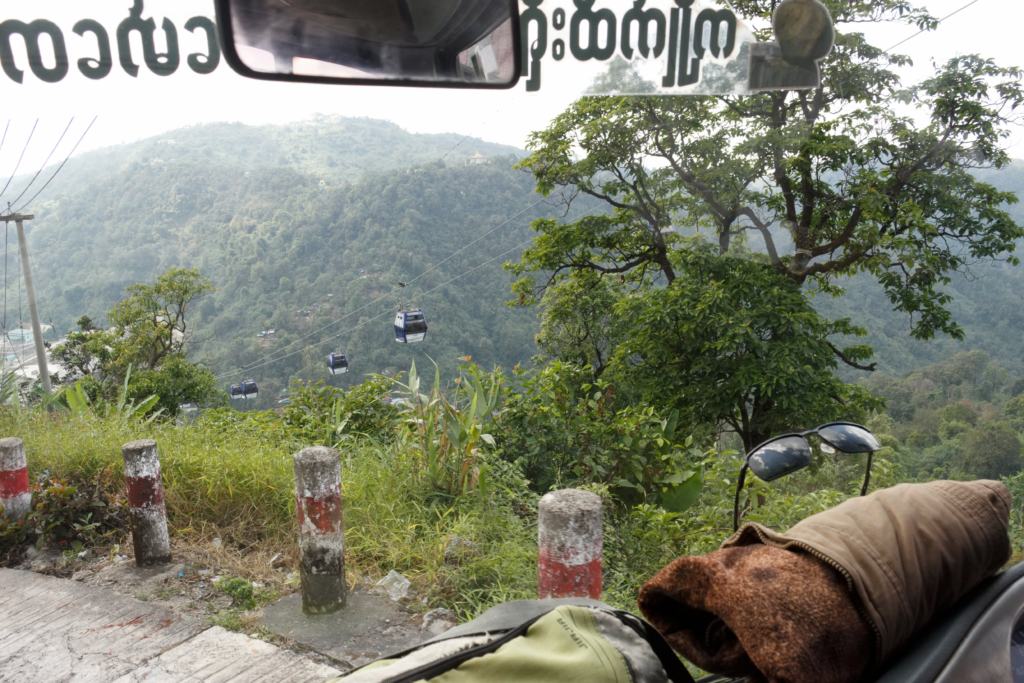
It is also possible to hike up the hill from this point. It will take about 45 minutes and you’ll get the best of both worlds. The breezy air is crisp in November and the rolling clouds provide cool shade from the midday sun. Along the path, villagers are crafting toys and weaving hats. There are plenty of shops selling snacks and water if you ever get tired and hungry.
The truck took us right up the entrance of Kyaikthiyo town. At this point, many porters will approach you to offer to carry your bags for a small price. Families who are planning to stay the night near the pagoda that brought luggage with them generally use this service.

Foreigners have to pay 10,000 kyats to enter the main compound. Note, also, that all women are held to a “modesty” dress code: as long as your knees and shoulders are covered, you will be allowed in. However, women aren’t allowed to the inner area where you can stick gold leaves to the rock. There are areas around the pagoda where women are allowed to pay homage, pray, and recite scripture.

From this point, everyone continues on foot to the Golden Rock, in the footsteps of the pious making their pilgrimage. Young, old, frail and strong all climbed together. However, if you have a disability and cannot hike — or maybe you simply want the royal treatment — then you can pay to be carried for 30 minutes on a bamboo stretcher with a cushioned chair.

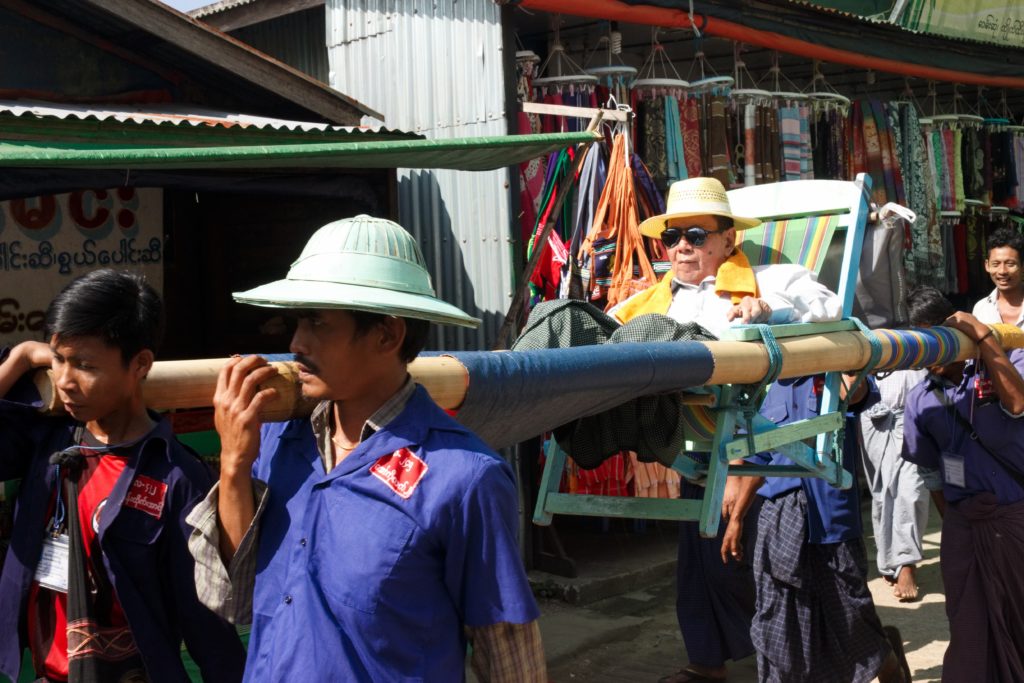
The walk up to the pagoda is lined with shops, restaurants, markets and hotels. Vendors are selling food, toys, hats and souvenirs for tourists and pilgrims alike.
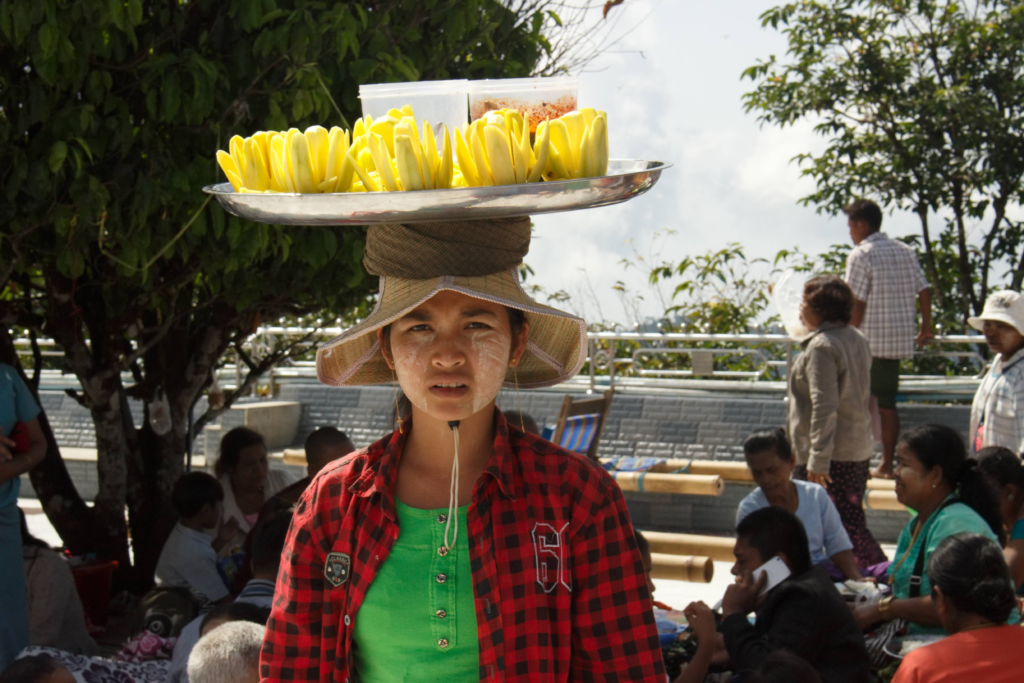


Once you’re up there, the views are breathtaking and the air is refreshingly different from what we get used to breathing in in Yangon.


You’ll likely have plenty of company, too. There are pilgrims chanting alongside children playing with each other between rows and rows of pilgrims resting under the shade.
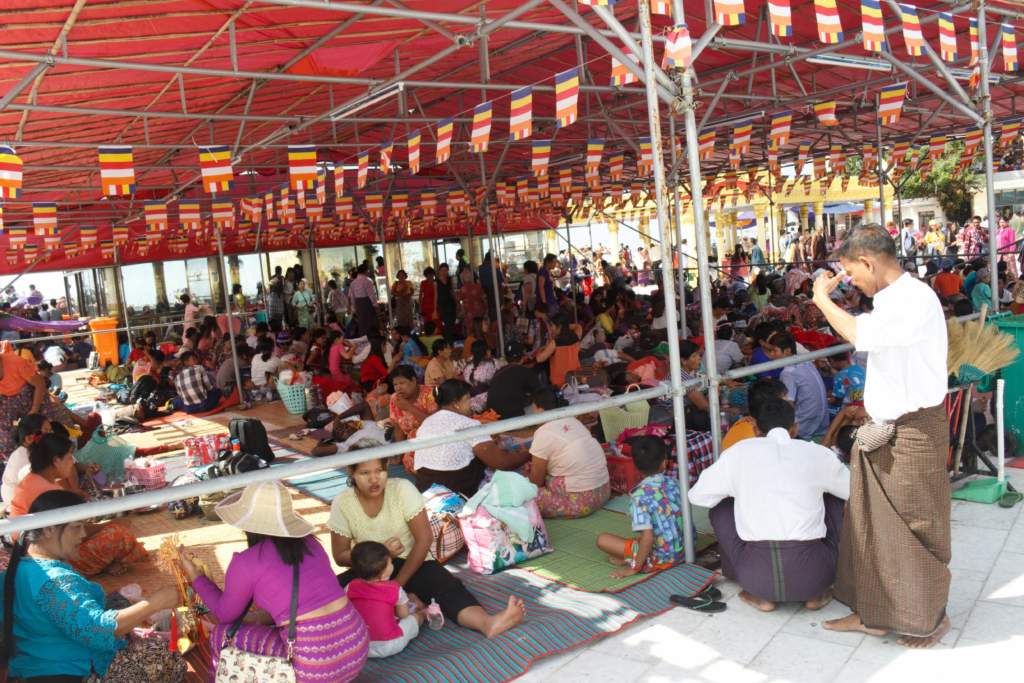
Closer to the pagoda, there is an air of devotion hanging as devotees meditate, make offerings to the Buddha, and solemnly pay homage to the pagoda.

A cloud of smoke rises from the hundreds of candles and incense sticks that are lit around the pagoda — smoke so thick that it’ll make your eyes water.
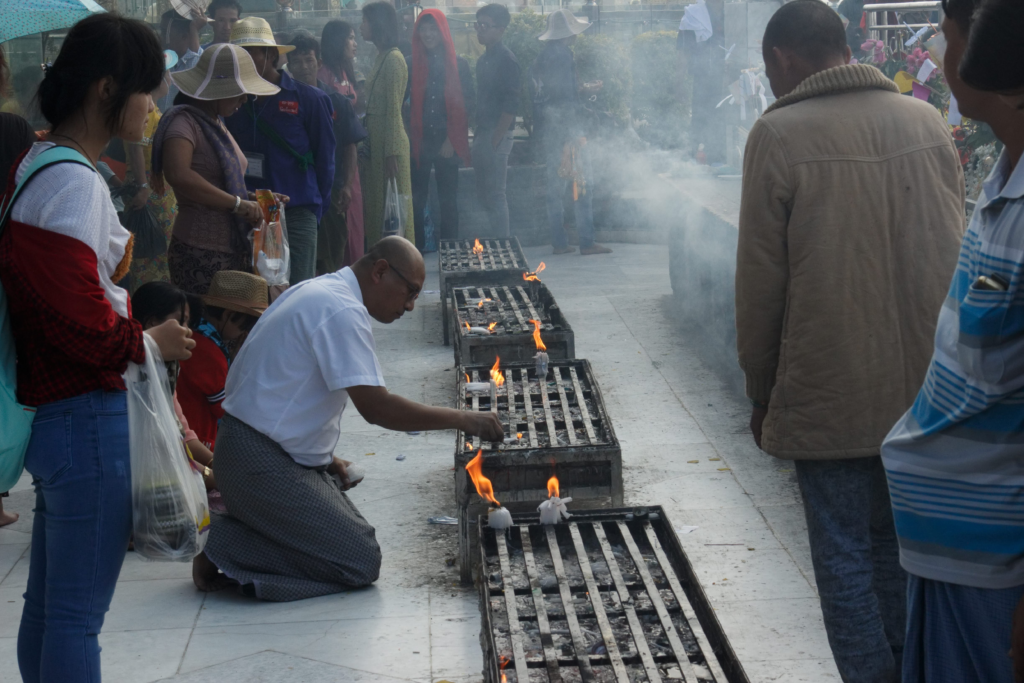
Past a security checkpoint, men are allowed to enter a platform where you can stick golden leaves to the Golden Rock. You can see the small bumps where devotees have stuck thin leaves to layers and layers of gold. Limited by the small platform, devotees praying and paying homage file in and out, taking turns to touch the sacred rock.

From a platform under the Golden Rock, you can sense the perilous balance that maintains its perch on the mountain. A quick peek below the rock reveals the potential for a sharp, scary drop, and the litter that has accumulated from thousands of previous visitors that have thrown away their gold leaf paper wrappings.

Regardless of the motivation of your visit — religious or not — we can tell you this: Seeing the Kyaikthiyo in person truly does instill a sense of awe, if at least for the geological marvel that it is. Add to that the palpable feelings of devotion coming from throngs of Buddhists paying their homage, and it makes for a seriously cool experience that can’t be found anywhere else.



Reader Interactions